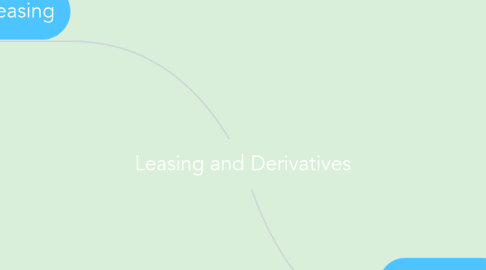
1. Leasing
1.1. A lease is an agreement that allows one party to use another’s property for a stated period of time in exchange for consideration.
1.2. Types of Leasing
1.2.1. Financial Lease
1.2.2. Operating Lease
1.2.3. Leveraged and Non-leveraged Lease
1.2.4. Conveyance type Lease
1.2.5. Sale and Leaseback
1.2.6. Full and non pay-out Lease
1.2.7. Specialized service Lease
1.2.8. Net and Non-net Lease
1.2.9. Sales aid Lease
1.2.10. Cross border Lease
1.2.11. Tax oriented Lease
1.2.12. Import Lease
1.2.13. International Lease
1.3. Leasing Arrangement
1.3.1. The user of the leased asset is called the lessee
1.3.2. The owner of the property, usually the manufacturer Copyright 2009 Health Administration Press 2 or a leasing company, is called the lessor
1.4. Buying-Leasing Decision
1.4.1. Involves applying capital budgeting principles to determine if leasing as asset is a better option than buying it.
1.4.1.1. Buying the asset involves purchase of the asset with company’s own funds or arranging a loan to finance the purchase.
1.4.1.2. We need to find out the periodic cash flows under both the options and discount them using the after-tax cost of debt to see where does the present value of the cost of leasing stands as compared to the present value of the cost of buying.
1.5. Leasing and Financing
1.5.1. The lessee reports lease payments as an expense item on the income statement in the year they are made.
1.5.2. If the lease is a capital lease, and hence is listed on the balance sheet
1.5.3. The leased asset is depreciated each year and the annual depreciation expense is reported on the income statement.
1.5.4. Under certain conditions, neither the leased asset nor the contract liabilities appear on the lessee's balance.
1.5.4.1. Leasing is often called off-balance sheet financing
1.6. Advantages and Disadvantages of Leasing
1.6.1. Advantages
1.6.1.1. Balanced Cash Outflow
1.6.1.2. Quality Assets
1.6.1.3. Better Usage Of Capital
1.6.1.4. Tax Benefit
1.6.1.5. Off Balanced Sheet Debt
1.6.1.6. Better Planning
1.6.1.7. Low Capital Expenditure
1.6.1.8. No Risk Of Obsolescense
1.6.1.9. Termination Rights
1.6.2. Disadvantages
1.6.2.1. Lease Expenses
1.6.2.2. Low Financial Benefits
1.6.2.3. Reduces Return For Equity Holders
1.6.2.4. Debt
1.6.2.5. Limited Access For Other Loans
1.6.2.6. Processing And Documentation
1.6.2.7. No Ownership
1.6.2.8. Maintenance For The Asset
1.6.2.9. Limited Tax Benefits
2. Derivatives
2.1. Financing and Convertible Securities
2.1.1. A convertible security is an investment that can be changed into another form.
2.1.1.1. Convertible bonds
2.1.1.2. Convertible preferred stock
2.1.2. A convertible security pays a periodic fixed amount as a coupon payment (in the case of convertible bonds) or a preferred dividend (in the case of convertible preferred shares).
2.1.3. It specifies the price at which it can be converted into common stock.
2.2. Types of Warrant
2.2.1. A derivative that confers the right, but not the obligation, to buy or sell a security – normally an equity – at a certain price before expiration.
2.2.2. The price at which the underlying security can be bought or sold is referred to as the exercise price or strike price.
2.2.3. Traditional warrants
2.2.3.1. Issued in conjunction with bonds, which in turn are called warrant-linked bonds that allows the issuer to offer a lower coupon rate.
2.2.4. Wedded or wedding warrants
2.2.4.1. Not detachable, and the investor must surrender the bond or preferred stock the warrant is "wedded" to in order to exercise it.
2.2.5. Covered warrants
2.2.5.1. Issued by financial institutions rather than companies, so no new stock is issued when covered warrants are exercised.
2.2.6. Trading warrants
2.2.6.1. Difficult and time-consuming
2.2.6.1.1. The most part not listed on stock exchanges, and data on warrant issues is not readily available for free.
2.2.7. Naked Warrants
2.2.7.1. Issued on their own, without accompanying bonds or preferred stock.
2.3. Warrant Valuation
2.3.1. Modified version of the Black-Scholes model is most common.
2.3.2. C = S N(d1) - X e-rT N(d2)
2.4. Foward Contract
2.4.1. a customized contract between two parties to buy or sell an asset at a specified price on a future date.
2.5. Future Contract
2.5.1. a legal agreement, generally made on the trading floor of a futures exchange, to buy or sell a particular commodity or financial instrument at a predetermined price at a specified time in the future.
2.6. Opinion Contract
2.7. Swap Contract
2.7.1. a derivative contract through which two parties exchange financial instruments.
